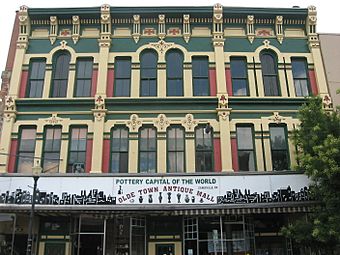Black-Elliott Block facts for kids
Quick facts for kids |
|
|
Black-Elliott Block
|
|

Front of the block
|
|
| Location | 525 Main St., Zanesville, Ohio |
|---|---|
| Area | Less than 1 acre (0.40 ha) |
| Built | 1876 |
| Architectural style | Italianate |
| NRHP reference No. | 79001914 |
| Added to NRHP | May 8, 1979 |
The Black-Elliott Block is a cool old building in downtown Zanesville, Ohio. It was built way back in 1876. This building is special because of its unique style. It looks like buildings from Italy, which is why it's called Italianate.
Contents
What is the Black-Elliott Block?
This historic building is located on Main Street. It's not far from the Muskingum County Courthouse. The Black-Elliott Block was designed to be a place for businesses. It has been a part of Zanesville's history for a very long time.
Who Built This Historic Building?
Two important businessmen, Henry Elliott and Peter Black, worked together to build it. They were responsible for several big buildings in Zanesville. One of their other projects was the Clarendon Hotel. The Black-Elliott Block was made from strong brick. It also has a solid sandstone foundation. Some parts of the building even use iron.
What Businesses Were Inside?
When the building was finished, both Henry Elliott and Peter Black opened their own stores inside. Peter Black's store took up about 16 feet of the front. Henry Elliott's store used about 15 feet. Henry Elliott also started the Elliott Paper Company in 1885. Peter Black was a leader at the First National Bank. Even after they passed away, people still called it the "Black-Elliott" block. Later, a big store called the S.S. Kresge Company was a main tenant. They were there from 1916 until 1977.
Why is it a Historic Place?
In 1979, the Black-Elliott Block was added to the National Register of Historic Places. This means it's a very important building in history. It earned this honor because of its amazing architecture. The outside of the building is especially unique. It's one of the only Italianate buildings from the late 1800s in Zanesville that hasn't changed much.



